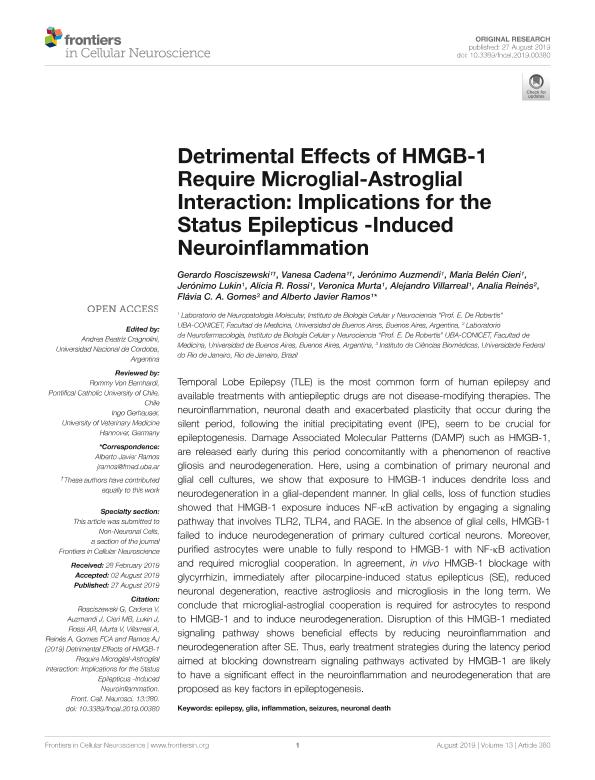Artículo
Detrimental Effects of HMGB-1 Require Microglial-Astroglial Interaction: Implications for the Status Epilepticus -Induced Neuroinflammation
Rosciszewski, Gerardo Ariel ; Cadena, María Vanesa
; Cadena, María Vanesa ; Auzmendi, Jerónimo Andrés
; Auzmendi, Jerónimo Andrés ; Cieri, María Belén; Lukin, Jeronimo
; Cieri, María Belén; Lukin, Jeronimo ; Rossi, Alicia Raquel; Murta, Verónica
; Rossi, Alicia Raquel; Murta, Verónica ; Villarreal, Alejandro
; Villarreal, Alejandro ; Reines, Analia Gabriela
; Reines, Analia Gabriela ; Gomes, Flávia C. A.; Ramos, Alberto Javier
; Gomes, Flávia C. A.; Ramos, Alberto Javier
 ; Cadena, María Vanesa
; Cadena, María Vanesa ; Auzmendi, Jerónimo Andrés
; Auzmendi, Jerónimo Andrés ; Cieri, María Belén; Lukin, Jeronimo
; Cieri, María Belén; Lukin, Jeronimo ; Rossi, Alicia Raquel; Murta, Verónica
; Rossi, Alicia Raquel; Murta, Verónica ; Villarreal, Alejandro
; Villarreal, Alejandro ; Reines, Analia Gabriela
; Reines, Analia Gabriela ; Gomes, Flávia C. A.; Ramos, Alberto Javier
; Gomes, Flávia C. A.; Ramos, Alberto Javier
Fecha de publicación:
08/2019
Editorial:
Frontiers Media S.A.
Revista:
Frontiers in Cellular Neuroscience
ISSN:
1662-5102
Idioma:
Inglés
Tipo de recurso:
Artículo publicado
Clasificación temática:
Resumen
Temporal Lobe Epilepsy (TLE) is the most common form of human epilepsy and available treatments with antiepileptic drugs are not disease-modifying therapies. The neuroinflammation, neuronal death and exacerbated plasticity that occur during the silent period, following the initial precipitating event (IPE), seem to be crucial for epileptogenesis. Damage Associated Molecular Patterns (DAMP) such as HMGB-1, are released early during this period concomitantly with a phenomenon of reactive gliosis and neurodegeneration. Here, using a combination of primary neuronal and glial cell cultures, we show that exposure to HMGB-1 induces dendrite loss and neurodegeneration in a glial-dependent manner. In glial cells, loss of function studies showed that HMGB-1 exposure induces NF-κB activation by engaging a signaling pathway that involves TLR2, TLR4, and RAGE. In the absence of glial cells, HMGB-1 failed to induce neurodegeneration of primary cultured cortical neurons. Moreover, purified astrocytes were unable to fully respond to HMGB-1 with NF-κB activation and required microglial cooperation. In agreement, in vivo HMGB-1 blockage with glycyrrhizin, immediately after pilocarpine-induced status epilepticus (SE), reduced neuronal degeneration, reactive astrogliosis and microgliosis in the long term. We conclude that microglial-astroglial cooperation is required for astrocytes to respond to HMGB-1 and to induce neurodegeneration. Disruption of this HMGB-1 mediated signaling pathway shows beneficial effects by reducing neuroinflammation and neurodegeneration after SE. Thus, early treatment strategies during the latency period aimed at blocking downstream signaling pathways activated by HMGB-1 are likely to have a significant effect in the neuroinflammation and neurodegeneration that are proposed as key factors in epileptogenesis.
Palabras clave:
EPILEPSY
,
GLIA
,
INFLAMMATION
,
NEURONAL DEATH
,
SEIZURES
Archivos asociados
Licencia
Identificadores
Colecciones
Articulos(IBCN)
Articulos de INST.DE BIOLO.CEL.Y NEURCS."PROF.E.DE ROBERTIS"
Articulos de INST.DE BIOLO.CEL.Y NEURCS."PROF.E.DE ROBERTIS"
Articulos(OCA HOUSSAY)
Articulos de OFICINA DE COORDINACION ADMINISTRATIVA HOUSSAY
Articulos de OFICINA DE COORDINACION ADMINISTRATIVA HOUSSAY
Citación
Rosciszewski, Gerardo Ariel; Cadena, María Vanesa; Auzmendi, Jerónimo Andrés; Cieri, María Belén; Lukin, Jeronimo; et al.; Detrimental Effects of HMGB-1 Require Microglial-Astroglial Interaction: Implications for the Status Epilepticus -Induced Neuroinflammation; Frontiers Media S.A.; Frontiers in Cellular Neuroscience; 13; 8-2019; 1-19
Compartir
Altmétricas



